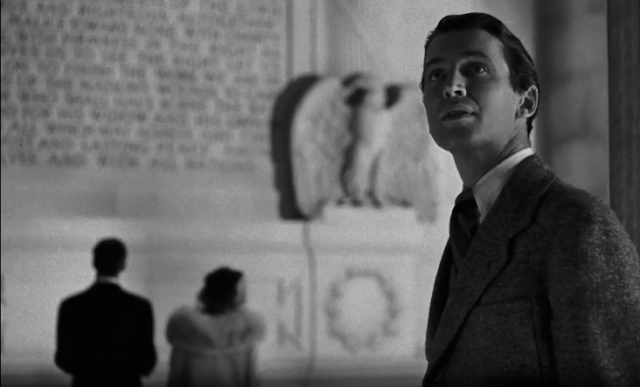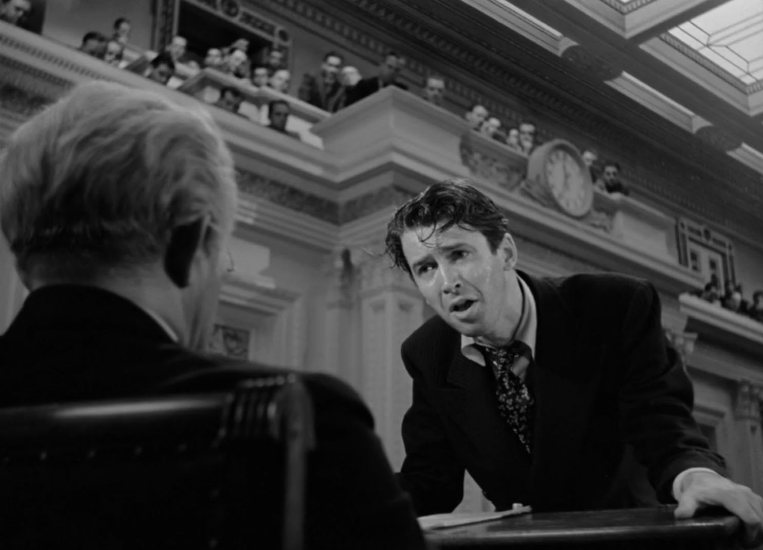 |
| James Stewart as Jefferson Smith, who’s down but not out, in 1939’s comedy-drama, “Mr. Smith Goes to Washington.” |
I never watched Mr. Smith Goes to Washington until 2025
for evolving reasons. First, I was not very political in my younger years,
so the subject matter didn’t interest me. Later, when I did become more invested in politics, I thought a Frank Capra movie
on the workings of Washington, D.C. would be too sentimental and clichéd.
Finally, after the last ten years of non-stop US political turmoil, I decided
to seek comfort in Mr. Smith’s political
journey.
I was taken aback watching Mr. Smith Goes to Washington. While
there was sentiment in this cinema classic, it is heartfelt. What really surprised
me was how strongly the political corruption was portrayed, and how powerful still
is Mr. Smith’s disillusionment with
the system. The latter is especially so when he collapses on the senate floor,
and only then is there a positive resolution.
In Mr. Smith Goes to Washington’s last act,
the naïve senator is railroaded by corrupt politicians, and it is great story
telling. While some of the David and Goliath aspects of Smith and his young
supporters versus the aging fat cats might be considered corny, there have been
similar real life incidents in recent US election cycles that show dirty tricks
haven’t changed all that much: biased press inciting the masses, running the
opposition literally off the road, and treating the opposition with aggressive
strong arm tactics.
 |
| James Stewart and Jean Arthur make a marvelous team in 1939’s “Mr. Smith Goes to Washington. |
The political story of
Mr. Smith Goes to Washington is
surprisingly in-depth and adult. The scene where Washington insider Clarissa Saunders
explains the cycle of creating a bill to Jefferson Smith is snappy and
priceless. The opening, with a death of a politician, the first concern is who
will replace him! Young Mr. Smith’s tour of the Washington monuments might make
you feel downright patriotic. The scene where Smith is thrown under the bus in
the Senate to deflect blame for corruption feels very current. And when Jefferson goes to lick his wounds at the Lincoln
Memorial, with Saunders touched by Smith’s tears, it is genuinely affecting. So
rare for an actor of this era to show his emotions, but that was one of James Stewart’s
strengths as an actor. And of course, Stewart’s great monologue, where he
filibusters to make his voice heard, and innocence believed. This set piece is
very powerful, which we just witnessed the power of a filibuster in real life, recently.
 |
| James Stewart gives his heart and soul to the role of Jefferson Smith in 1939’s comedy-drama, “Mr. Smith Goes to Washington.” |
The entire cast of Mr. Smith Goes to Washington is
terrific. In the title role as Jefferson Smith, this is the embodiment of James
Stewart’s screen persona. Director Frank Capra cast him because he immediately
saw that Stewart’s small town genuineness was perfect for everyman Smith. Jimmy
is authentic throughout, as his character is put through the wringer. Movie
making in 1939 was considered the peak year in film. In any other year, Stewart
would have won the Best Actor Oscar. He got a makeup award the next year for The Philadelphia Story. But hey,
that guy who played Rhett Butler lost out in ’39, too!
 |
| Jean Arthur plays pragmatic yet spirited reporter Clarissa Saunders, who comes to believe in James Stewart’s new senator, in 1939’s “Mr. Smith Goes to Washington.” |
Jean Arthur plays the
experienced, pragmatic reporter and performs in an understated style, rather
than the quirky fusspots she later played. Jean’s nervous energy plays well against Stewart’s laid-back demeanor. Arthur’s Clarissa Saunders has a subtle
character trajectory, going from cynical disbelief of innocent Smith to
admiring his integrity, to falling in love with him. Jean plays each phase
beautifully without a false note.
Frank Capra’s perennial
favorites are here: This is Jean Arthur’s third time as a Capra leading lady;
there’s Thomas Mitchell as Arthur’s fellow reporter; H.B. Warner as a
politician; Edward Arnold, perfectly cast as charismatic but corrupt
businessman named James Taylor; and
Beulah Bondi’s first time out as Jimmy’s Ma. Stewart appeared in three Capra
film, and like the later It’s a Wonderful
Life, he’s serenaded with Auld
Langsyne.
 |
| Beulah Bondi is once again Jimmy Stewart’s loving Ma in 1939’s comedy-drama, “Mr. Smith Goes to Washington.” |
Capra always had
marvelous ensemble casts in his films, this may be the best: Guy Kibbee as the
pliable politician who surprises by picking Stewart’s Jefferson Smith as the
next senator; Harry Carey, so wryly expressive as the president of the Senate;
Eugene Pallette, very funny as Chick, who’s in charge of herding Smith; and
best of all, Claude Rains as Senator Joseph Paine, who was best friends with
Smith’s father, but is now conflicted between corruption and conscience. Rains
gets to run the gamut in his juicy supporting role: subtle, grand, gentle,
glib, charming, rotten—everything! My only criticism with Claude is that his
hair was dyed a distractingly snow white. At almost 50, Rains was still 20
years older than Stewart, believable enough as a contemporary of Smith’s
father. Finally, look for a very young Jack Carson as a reporter.
 |
| Whose idea was it to dye Claude Rains hair snow white at 50 for his role in 1939’s comedy-drama, “Mr. Smith Goes to Washington?” |
There was a fair
amount of location shooting for the era in Mr.
Smith Goes to Washington, and the images are powerful. In particular, those
of James Stewart gazing at Abraham Lincoln—two lanky icons! This entire
sequence evokes some powerful feelings. The meticulous reproduction of the
senate chamber is striking, a most impressive and convincing set. The script is
filled with memorable lines, several worth repeating today! Sidney Buchman and
Myles Connolly were Mr. Smith’s
screenwriters.
 |
| Two icons gaze at each other in 1939’s “Mr. Smith Goes to Washington.” |
 |
| I love this scene, where Jimmy Stewart looks on in awe at the Lincoln Memorial, in 1939’s “Mr. Smith Goes to Washington.” |
At just over two hours,
Mr. Smith sags just a bit in the
middle. The Jean Arthur and Thomas Mitchell quasi-romance could have been
trimmed a bit. And that cutesy bit with Stewart’s Smith continually dropping
his hat in front of Senator Paine’s glamorous daughter is a bit much.
Frank Capra, an Italian
immigrant who hailed America, created a great movie with Mr. Smith, about how the fight for democracy is never-ending. While
the homespun aspects of this story might put some viewers off, the bigger
picture of Capra’s storytelling still resonates deeply. Even for those who call
his work “Capra-corn” or naively populist, well, the man had his point of view.
And Frank Capra expressed it skillfully in his work.
 |
| James Stewart with director Frank Capra at the Lincoln Memorial for a scene in 1939’s “Mr. Smith Goes to Washington.” |
The machinations of
monopolies, big business buying politicians, and dissenters getting crushed,
all seems very familiar and timely, sad to say. To get his message across, Capra
wisely didn’t pin identifying labels on the crooked politicians and money men.
Mr. Smith Goes to Washington was promoted and hailed as Capra’s best work in
1939. For once, the Hollywood hyperbole was correct. This indeed was Frank’s
last film that was both critically and commercially successful. He had more
money makers later, but very few critical hits. One film that was underrated at
the time later became his signature film, It’s
a Wonderful Life.
 |
| “Mr. Smith Goes to Washington” was indeed director Frank Capra’s greatest hit! |
Here’s my look at
Frank Capra’s American version of A Christmas
Carol, It’s a Wonderful Life: https://ricksrealreel.blogspot.com/2016/12/its-wonderful-life-still-has-wonder-70.html
And here’s Jean
Arthur, where this time she’s the idealistic politician, visiting war-torn
Berlin, in Billy Wilder’s comedy-drama, A
Foreign Affair: https://ricksrealreel.blogspot.com/2023/05/billy-wilders-adult-foreign-affair-1948.html
 |
| Jimmy Stewart was perfectly cast as the idealistic new senator, Jefferson Smith, in 1939’s Frank Capra classic comedy-drama, “Mr. Smith Goes to Washington.” |
